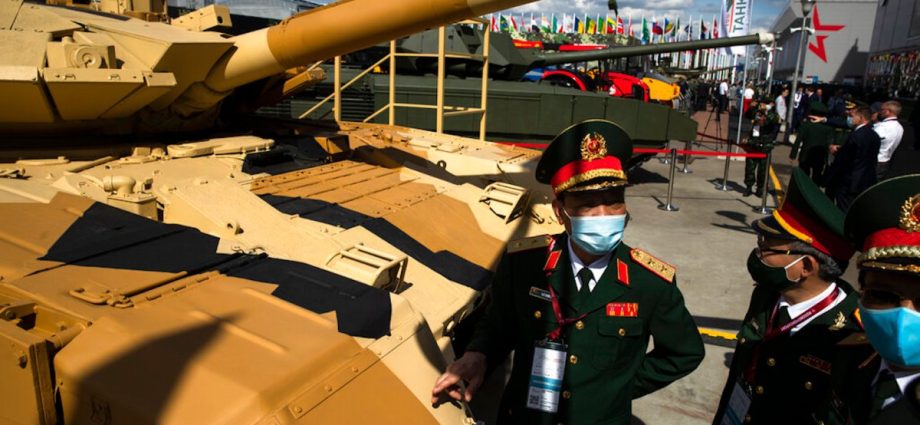
Russia continues to pitch arms sales to Southeast Asia, pinning its hopes on the economically vibrant and strategically challenged region to save its embattled weaponry industry amid the ongoing Ukraine war and punitive Western sanctions.
This month, Asian Military Review reported that Russia is looking at new opportunities for “military-technical cooperation” – Russian parlance for arms sales – with Association of Southeast Asian Nations (ASEAN) members.
In an interview with Russian Aviation & Military Guide (RAMG), Dmitry Shugaev, director of Russia’s Federal Service for Military-Technical Cooperation (FSMTC), said that Russia enjoys good diplomatic relations with ASEAN states, with all parties reputedly maintaining active dialogue on “military-technical cooperation” issues.
In the same interview, Shugaev noted that Russia has been an ASEAN Dialogue Partner since 1996 and that a legal and regulatory framework for such cooperation has long been established.
Shugaev criticized Western diplomatic pressure and sanctions for undermining Russia’s arms exports to the region while claiming that alternative payment mechanisms in national and other currencies have recently been formed. He also said that Russia is open to new joint production schemes with the bloc’s members.
Russia’s arms exports have slowed since the Ukraine war, including to Southeast Asia’s growing markets. David Brennan and Yevgeny Kuklychev note in a March 2023 Newsweek article citing data published this year by the Stockholm International Peace Research Institute (SIPRI) that Russia’s total military exports have fallen by 31% over the past five years compared with the previous five years.
Western sanctions on Russia over its 2014 annexation of Crimea have slowly chipped away at Russia’s defense industry, undermining its position as the world’s second-largest arms exporter, the authors said.
Brennan and Kuklychev note that Russia’s global arms exports fell from 22% to 16% of the world market between 2013 and 2017 and from 2018 to 2022, leaving it in the dust of the US, which accounts for 40% of global exports, and only slightly ahead of France, which accounted for 11% over the last five years.
An anonymous source cited by the writers said that Russia’s export contracts have been relegated to “last priority” as Moscow doubles down on trying to replace its battle losses in Ukraine.
The same unnamed source mentioned that Russia would face considerable difficulties in fulfilling export contracts as foreign-made parts become harder to source due to sanctions and with its domestic arms industry struggling to produce substitute components. The anonymous source said that the poor performance of Russian weapons in Ukraine is a “demonstration” of their inferior quality.
The source estimated Russia could fall from among the world’s top arms exporters, with its future market confined to selling relatively low-tech weapons to impoverished, sanctioned and pariah states via barter mechanisms while losing its market share of high-end weapons to competitors like the US.
Before the Ukraine war, Russia was the leading arms supplier to Southeast Asia. In a May 2022 article for The Diplomat, Sebastian Strangio notes that between 2001 and 2021 Russia shipped US$10.9 billion worth of arms to the region, leading other major arms exporters including the US ($8.4 billion), France ($4.3 billion), Germany ($2.94 billion), and China ($2.9 billion).
Strangio notes that Russia’s main comparative advantage over other arms exporters in Southeast Asia is price and its willingness to sell weapons to rights-abusing states such as Myanmar and Cambodia, which are under various Western sanctions and embargoes.
Southeast Asian countries continue to buy Russian weapons amid intensifying US-China strategic competition. David Hutt mentions in a May 2022 article for DW that Southeast Asian nations are hedging between the US and China regarding their arms purchases, as big arms purchases from either would potentially peeve the other.
Hutt notes that buying weapons from Russia is viewed, within certain limits, as acceptable by both superpowers. He notes that the US is reluctant to sanction Southeast Asian states like Vietnam and Indonesia for buying Russian arms when its top diplomatic priority is to rally regional states against China.
Mike Ives writes in a November 2022 article in the New York Times that, from 2017 to 2021, South Korea eclipsed Russia as Southeast Asia’s top arms supplier, accounting for 18% of the region’s arms purchases over the period. No other global exporter accounted for more than 14% of the region’s arms exports, according to the report.
Ives also claims that the US is increasingly seen as an attractive arms supplier, even as the US increasingly ties its arms exports to diplomatic and military support against China. He also says European arms suppliers have been willing to sell arms to Southeast Asian states to grow their defense industries, with some cases involving significant technology transfer.
Despite Russia’s challenges in maintaining its grip on Southeast Asian arms markets, Vietnam may remain Russia’s reliable customer.
Le Hong Hiep notes in an April 2022 Fulcrum article that Vietnam is Russia’s 5th largest arms customer, with Russia accounting for 90% of Vietnam’s arms imports from 1995-2014 and 68% from 2015-2021. Hiep notes that Vietnam’s limited defense budget means it could not afford more expensive Western arms.
He also says compatibility between Russian and newer non-Russian weapons will be problematic. The writer notes that many senior Vietnamese military officers who trained in the Soviet Union or Russia are accustomed to doing business with their Russian counterparts and may find it challenging to deal with more transparent and demanding Western business cultures.
Indeed, Richard Bitzinger and Kenneth Boutin state in an August 2022 East Asia Forum article that Russia’s complementarity to the US and its “no strings attached” approach to arms sales means it is likely to remain a long-term arms supplier to Southeast Asian states, despite the bloc’s attempts to diversify its sources.
Bitzinger and Boutin note that Southeast Asian arms markets such as Myanmar, Cambodia and Vietnam will likely continue to provide much-needed funding for Russia’s struggling defense industry, alleviating a problem predating the Ukraine war.

